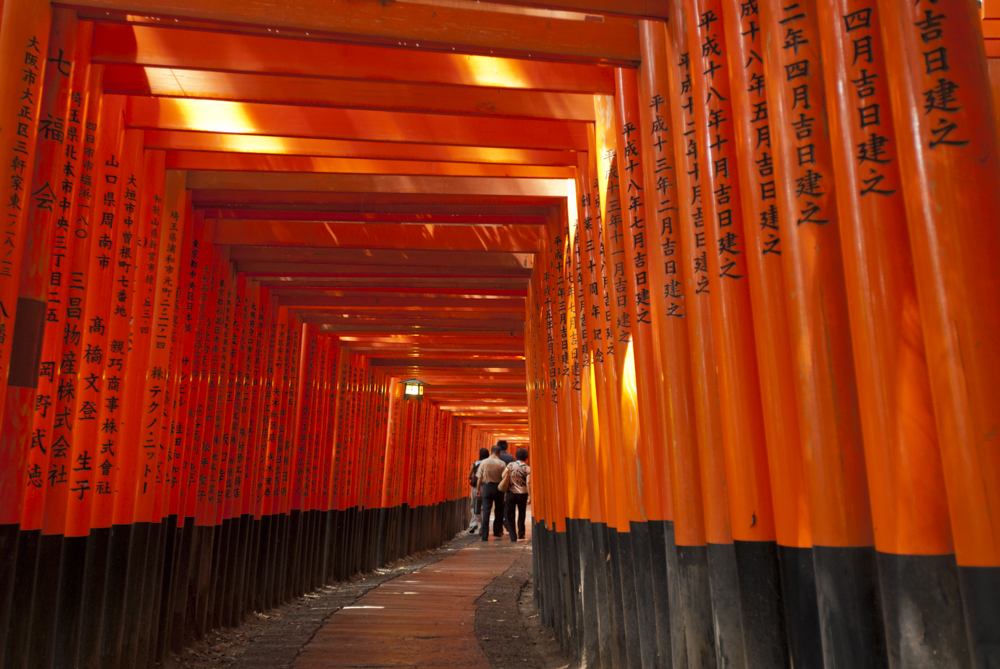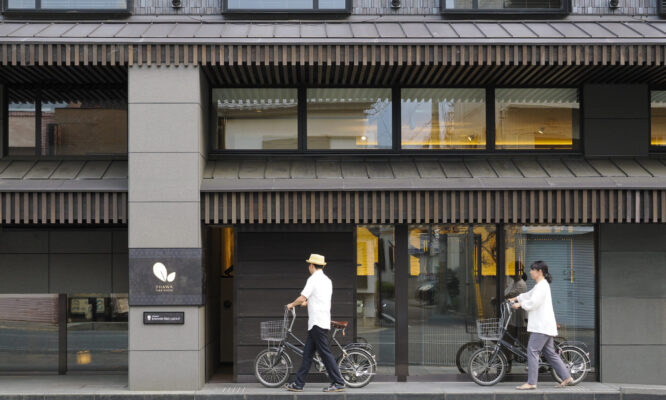Turn every corner in Kyoto and be reminded of its glorious past.

One thousand years is a long time to be the capital of a country, and that millennium certainly left its mark on Kyoto. Everywhere you go, there are reminders of the Japanese city’s former glory: Shinto shrines, Buddhist temples, Zen gardens, palaces, theatres, traditional craftsmen’s workshops and more. Down every street, it seems, there are wonderful discoveries waiting to be made; Kyoto rewards those who head out and start walking.

Temples, Shrines and Rock Gardens
Of course, there are marquee attractions to have at the top of your list, such as Kinkakuji – the Golden Pavilion. Completely coated in gold leaf, this three-storey masterpiece was originally a villa built by the shogun, the country’s top general, around 600 years ago; it was converted into a Zen temple only after he died. What you see today is a reconstruction, the original having burned to the ground in 1950, but it’s no less magnificent for being new. It’s even more impressive when it has a backdrop of fall foliage or a dusting of snow. After marvelling at the gleaming exterior of Kinkakuji, you’d expect Ginkakuji – the Silver Pavilion, located to the east – to be coated in silver. It’s not, but some people find it and the surrounding gardens to be more relaxing than Kinkakuji.

The temple known as Kiyomizudera sits on a hillside on the eastern fringe of the city, giving a nice overview of Kyoto. Getting there is half the fun because you must climb the winding, character-rich lanes of the Higashiyama neighbourhood to reach it. With an overall history of some 1,200 years, Kiyomizudera in its present form dates back about 400 years, its wooden halls having been constructed using meticulous joinery techniques, without any nails. It’s surrounded by a wooden deck from which people used to jump; they believed that if they survived the 13-metre fall, their wishes would be fulfilled. A less painful way of getting your wish to come true is to try to catch some of the water cascading from the nearby Otowa waterfall and then drink it.

From Kiyomizudera, head south to Fushimi Inari Jinja, a Shinto shrine (Shinto is a religion that predates the arrival of Buddhism in Japan). There are Inari shrines across Japan, all featuring vivid orange gates called torii, but nowhere else will you see the hundreds of torii found here. There are so many of them, so tightly spaced, that visitors essentially walk through an orange tunnel, each torii painted on the side with the name of the donor. This is one of the country’s most popular attractions; if you want a photo without the crowds, try first thing in the morning or late in the afternoon on a rainy day, but even then, you’ll probably have to be patient.

Kyoto is justifiably famous for its serene rock gardens; the best-known is at Ryoanji, a walkable distance west of Kinkakuji. Some 250 square metres in size, it consists of raked gravel and 15 larger rocks, arranged in a way that no more than 14 can be seen from any position around the garden’s perimeter (‘garden’ is a bit of a misnomer, for the only vegetation is the moss surrounding the clusters of rocks). It was intended to help the temple’s monks as they meditated on the wooden deck of the abbot’s residence; if they attained enlightenment, it was believed only then would they be able to see all 15 rocks at once.

Ryoanji is by no means the only place in Kyoto to seek enlightenment. Kenninji, a temple in the Gion district, also has a nice rock garden, offering something that Ryoanji doesn’t: a spectacular ceiling painting of two dragons in one of the halls. Another option is to walk north from Fushimi Inari Jinja to a temple called Tofukuji, which has four distinctly different gardens, one on each side of the abbot’s residence. There’s a single dragon painted on the ceiling of a hall here too, but it’s more difficult to see than the double dragons of Kenninji.

Farther afield lies the district of Arashiyama. Here too you’ll find plenty of temples and shrines, but the most famous attraction is the Sagano bamboo groves, through which run picturesque lanes lined with fences. The whole area is ideal for strolling, but if you run out of energy, you can hire a rickshaw to pull you around. Rickshaws were invented in Japan – the English word is a corruption of jinrikisha, or ‘people-powered vehicle’ – and though they fell out of favour with the advent of automobiles, some young men today (and a few women) see them as a chance to get a vigorous exercise and be paid for it!

Kimonos, Japanese-style Hijabs and Halal Food
Once you’ve ticked all the famous attractions off your list, it’s time to find your own personal attractions, ones that don’t appear in any sightseeing guidebook. What better way to do that than in a kimono? Dressing up in a kimono is an extremely popular activity in Kyoto, for Japanese and foreign visitors alike, for women in particular but also men. There’s no shortage of kimono rental agencies, but Yumeyakata offers a little extra: it has Japanese-style hijab. At its main store in Gojo or its Oike Bettei branch, the latter located inside a traditional machiya house, you can take all the photos you want before changing back into your regular clothes, or you can venture out into the streets of Kyoto and return your kimono later in the day.

Interested in taking a Japanese hijab home with you? Try Kyoto Handicraft Centre, just northwest of Heian Shrine. It offers square and rectangular hijab in a variety of colours and styles, but that’s just the beginning: you can also buy a wide range of souvenirs and artwork from all corners of Japan – lacquerware, fans, wall hangings, tea ceremony tools and much more.

Recent years have seen a jump in the number of options available for halal food. In the Gion district, Naritaya serves 100 percent halal gyudon (sliced beef and onions on top of a bowl of rice) and ramen. In the northwest of the city in the Arashiyama neighbourhood, Yoshiya Okunoniwa serves excellent Japanese-style meals in a lovely setting – and it’s all halal. There’s also a tatami-floored prayer room with washing facilities. If you want to learn how to make your own ramen, the Ramen Factory, about one kilometre east of Kyoto Station, provides lessons in English. Here too everything is halal, and a prayer room is available.

Kyoto has a huge variety of accommodation, including Hotel Granvia, conveniently located in the Kyoto Station complex. Halal food is served in both its elegant Japanese restaurant, Ukihashi, and the more casual restaurant, Le Temps; on request, the hotel will provide prayer mats. There is a Qibla in all guest rooms.
For an entirely different experience, try one of the city’s capsule hotels, such as the sleek, futuristic Nine Hours, near the popular Gion area. Men and women sleep on different floors (served by different elevators) in individual pods with shared washroom facilities. It’s the closest most of us will ever come to sleeping in a spaceship – but it’s a lot more affordable than space travel.
Fast Facts:
- Kyoto was the home of the emperor, and thus, the capital of Japan, from the late eighth century to the middle of the 19th century.
- Originally called Heiankyo, it was modelled after Chang’an (known today as Xi’an), the Chinese capital city in the 8th century.
- Unlike most large Japanese cities, Kyoto was not extensively bombed during World War II and still has many traditional buildings.
- Ringed by mountains, Kyoto can be unpleasantly hot in summer and cold in winter.
- Despite the mountains on all sides, the city itself is flat, and rented bicycles are an increasingly popular way for visitors to get around.









